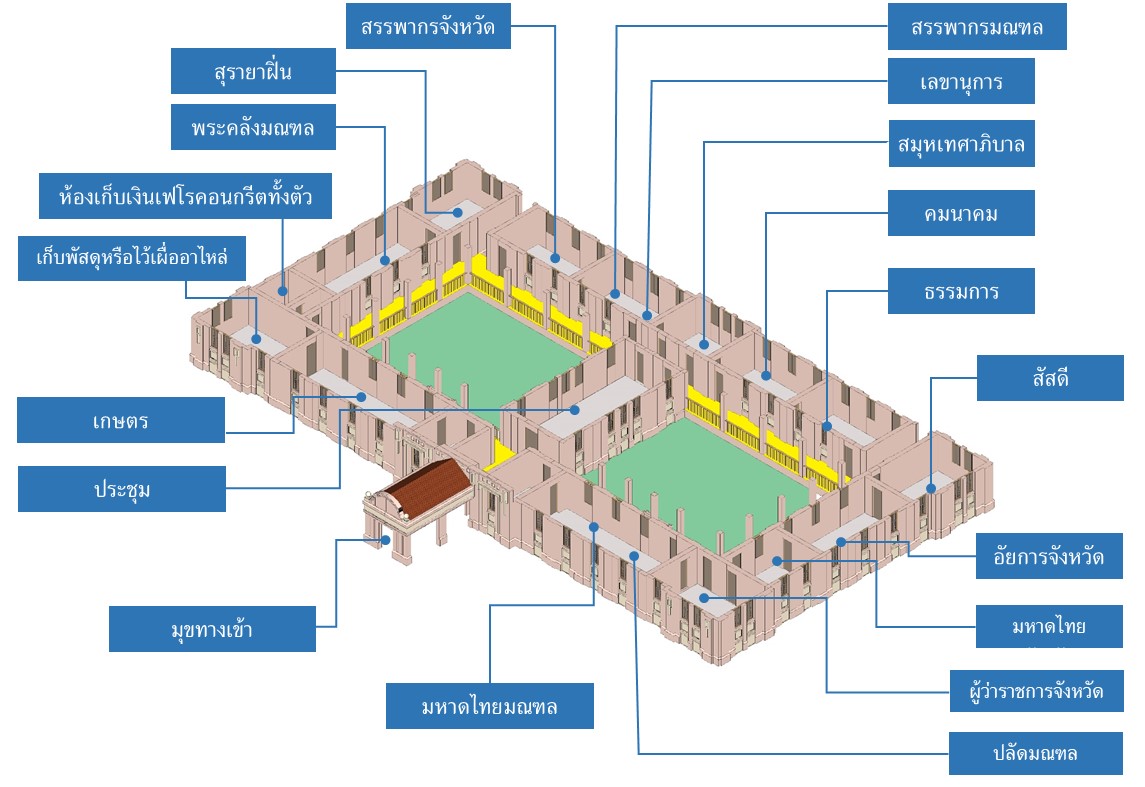Meaning of Garuda Emblem and Relationship of City Hall Architecture in the Age of Monthon Tesaphiban : A Case Study of Monthon Tesaphiban in Isan
Main Article Content
Abstract
This article aimed to search the meaning of Garuda and the relationship of city hall architecture in the age of Monthon Tesaphiban in Isan area. The study was conducted by mixed method between genealogical and semiological concept. Results revealed that the Garuda emblem at the gable of city hall was regarded as a great seal of the realm affixed on such building, as same as on royal letters or other documents that needed to be affixed the seal to indicate supreme power of the king. Therefore, the city hall building was a royal representative and also made its surrounding areas be a royal territory, due to the building was located on the land and was the center of local administration that had its exact boundary. Moreover, the Garuda emblem had its meaning in cosmological concepts in Tribhumi (the tree spheres) and as a royal symbol. After installing of the Garuda emblem, the meaning of such building was adjusted to conform with new context of the governance on such territory. The building was represented the governance in absolute monarchy state and differed from the governor’s residence previously that did not represented the royal power from central administration. The building and Monthon Tesaphiban, therefore, had their meanings as the sign of royal power directly. Existence of the city hall architecture, installed with the Garuda emblem, was the establishment of royal power over surrounding areas of such building and also regarded as the microcosm at the center of such place.
Downloads
Article Details

This work is licensed under a Creative Commons Attribution-NonCommercial-NoDerivatives 4.0 International License.
All material is licensed under the terms of the Creative Commons Attribution 4.0 International (CC-BY-NC-ND 4.0) License, unless otherwise stated. As such, authors are free to share, copy, and redistribute the material in any medium or format. The authors must give appropriate credit, provide a link to the license, and indicate if changes were made. The authors may do so in any reasonable manner, but not in any way that suggests the licensor endorses you or your use. The authors may not use the material for commercial purposes. If the authors remix, transform, or build upon the material, they may not distribute the modified material, unless permission is obtained from JARS. Final, accepted versions of the paper may be posted on third party repositories, provided appropriate acknowledgement to the original source is clearly noted.
References
Barth, A. (1906). The religions of Indian (J. Wood, Trans.) (4th ed.). London: Kegan Paul Trench Trubner.
Barthes, R. (1957). MYTHOLOGIES. (A. Lavers, Trans.). New York: The Noonday press.
Department of Textbooks Ministry of Education. (1925). Textbook geography. Bangkok:Bang Khun Phrom.
Hopkins, E. W. (1968). Epic Mythology. Delhi: Indological Book House.
Foucault, M. (1980). Power/Knowledge: Selected Interviews and Other Writings, 1972–1977. Edited by Colin Gordon. New York: Pantheon Books.
Foucault, M. (1984). Space, knowledge, and power. In P. Rabinow (Ed.), The Foucault reader. New York: Pantheon.
Lithai, King. (2000). Tri Bhumi Phra Ruang (8th ed.). Bangkok: Bannakan Publishing House.
Macdonell, A. A. (1971). Vedic Mythology. Delhi: Indological, Book house.
Ministry of Interior. (1992). 100 years Ministry of Interior. bangkok: Sirivatana, 1992.
Muangma, C. (2014). Chiang Rai. Retrieved November 24, 2020 from https://sites.google.com/site/sawatdeechaingrai/2-wathnthrrm
Pakdeekham, S. (2013). Garuda, the Vehicle of Vishnu. Bangkok: Amarin Printing.
Pengpongsa, Y. (1978). “Garudas and Nagas in Sanskrit and Pali Literature”. Master’s Degree in Eastern Language, Graduate School, Chulalongkorn University.
Phlainoi, S. (1984). Knowledge of Seals and the Privy Seal. Bangkok: Aksorn Pittaya Printing.
Pinaphang K., & Weerataweemat, S. (2019). “Government Architecture in Isan: Literature Review and Suggestion for Educational Guidelines.” Creative Local Wisdom. Chiang Mai: Chiang Mai University.
Prakitnonthakan, C. (2013). Arts and Architecture in the Reign of King Rama I: Concept, Symbolism and Social Meaning of Early Rattanakosin Period. Journal of Fine Arts, 4(1), 243-324.
Preyawanit, N. (2014). The City Center of the Early Rattanakosin Period. Na Jua. Journal for History of Architecture and Thai Architecture, 11 (2014), 34-63.
Saisingha, S. (2008). Craftsmanship in the Reign of King Rama II. Bangkok: Matichon Publishing House.
Secretariat of the Cabinet. (1995). The Privy Seal. Bangkok: Amarin Printing.
Silpakorn University. (1982). Sculptures of Rattanakosin. Bangkok: Graphic Art Publishing House.
The Association of Siamese Architects under Royal Patronage. (2017). The Association of Siamese Architects under Royal Patronage. Retrieved April 9, 2020 from https://asa.or.th/contact-us/
The Secretariat of The Cabinet. (2018). The Secretariat of The Cabinet. Retrieved April 10, 2020 from https://www.soc.go.th/
Tourism Authority of Thailand Northeastern Region. (2020). Tourism Authority of Thailand Northeastern Region.Retrieved November 24, 2020 from https://i-san.tourismthailand.org/
Weerataweemat S. (1999). Royal Buddhist architecture of the early Bangkok period :investigations in symbolic planning. (Doctor of Philosophy of Advanced Architectural Studies), University of York.


